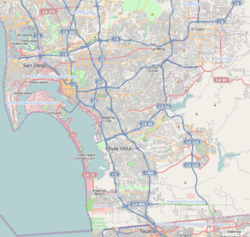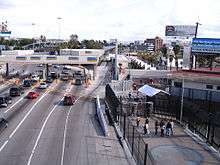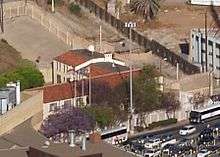San Ysidro, San Diego
| San Ysidro, San Diego | |
|---|---|
| Community of San Diego | |
| San Ysidro | |
|
Traffic approaching the San Ysidro Port of Entry | |
 San Ysidro, San Diego Location within Southern San Diego | |
| Coordinates: 32°33′18″N 117°02′40″W / 32.5549°N 117.044306°W | |
| Country |
|
| State |
|
| County |
|
| City |
|
San Ysidro (Spanish pronunciation: [san iˈsiðɾo]) is a district of the City of San Diego, immediately north of the U.S.-Mexico border. It neighbors Otay Mesa West to the north, Otay Mesa to the east, and Nestor and the Tijuana River Valley to the west; together these communities form South San Diego, a pene-exclave of the City of San Diego,[1] thus making it possible to travel (by water) between central San Diego and South San Diego without ever leaving the city limits. Major thoroughfares include Beyer Boulevard and San Ysidro Boulevard.
History
San Ysidro is named for San Ysidro Labrador (Saint Isidore), patron saint of farmers.
Little Landers
The Little Landers colony was a community founded by William Ellsworth Smythe in 1908 with the motto, "A little land and a living surely is better than desperate struggle and wealth possibly." Each member of the community held a plot of land no bigger than they could cultivate themselves, averaging 2 acres (8,100 m2) each, in order to foster a non-hierarchical social structure.[2] Every person had an equal voice in the affairs of the community whose business affairs was conducted by a board of directors voted in by the community. All agricultural buying and selling was pooled on a cooperative basis. Members agreed to forfeit their land should they leave the community.
The city levied a commission on the sale of land which funded public improvements such as a library, park, irrigation systems, and a clubhouse. They maintained a retail market in San Diego where harvested produce was sold. In addition to growing vegetables, the community raised and marketed ducks, rabbits, and goats.[3][4]
The Little Landers community is known as one of the nation's first communes.[3] It lasted until a major flood wiped out its farms in 1916.[5][6]
Annexation
San Ysidro, along with the rest of South San Diego, was annexed by the city of San Diego in 1957; an attempt by residents in 1973 to reverse the decision was unsuccessful.[7]
1984 massacre
On July 18, 1984, James Oliver Huberty, a 41-year-old former welder from Canton, Ohio, opened fire inside a McDonald's restaurant with multiple firearms, killing 21 people and injuring an additional 19, before he was fatally shot by a sniper from a SWAT team. The McDonald's site was razed in 1985. The site is now home to a Southwestern College satellite campus.[8]
See also
The use of Y in other languages' writing systems
Border crossing


San Ysidro is home to the what is often mistakenly stated to be the world's busiest land border crossing,[9][10] where U.S. Interstate 5 crosses into Mexico at Tijuana; however, the U.S. government only states that it is the busiest in the Western Hemisphere.[11][12] Statistics from the U.S. Department of Transportation state more than 14 million vehicles and 33 million people entered the United States at the San Ysidro Port of Entry in 2015.[13] The great majority of these are workers (both of Mexican and U.S. nationality) commuting from Tijuana to jobs in the greater San Diego area and throughout southern California. There is also reverse traffic, both of workers traveling to maquiladoras in Mexico and those purchasing services or seeking entertainment in Tijuana. 2009 studies estimated that wait times for vehicles at the San Ysidro LPOE averaged 1.5 to 2 hours during the commuter peak period.[14]
For pedestrians, in 2012, morning waits to enter the United States could last more than two hours — and twice that time during peak weekend periods. Roughly one-fifth of the 25,000 daily northbound crossers remained in San Ysidro to work, shop, visit family etc., according to the San Ysidro Chamber of Commerce. Many more boarded the San Diego Trolley or other public transportation to work, schools, stores, banks, medical appointments and family gatherings across San Diego County.[15] In 2016 a second pedestrian crossing was opened, "PedWest", connecting Plaza Viva Tijuana via a walkway to the border next to the El Chaparral auto crossing, with Virginia Avenue in San Ysidro.
San Ysidro is also where ICE deports the most Mexicans back into Mexico; in 2003, this was 360,172 people.[16]
Trucks cannot use the San Ysidro crossing and must use the Otay Mesa Port of Entry instead.[17]
An expansion of the San Ysidro Port of Entry is taking place in three parts and is scheduled to be completed in the spring of 2014. The $577 million project will expand and veer Interstate 5 to the west. Slated to be built are a new northbound inspection facility, including primary vehicle inspection booths, a secondary inspection area, an administration space, and a pedestrian-processing facility. A new southbound inspection facility is also planned.[18][19][20]
Emergency services
Police
The San Diego Police Department provides police services to the community. The area is serviced by the southern division headquarters at 1120 27th Street and a small substation at 663 E. San Ysidro Blvd.[21]
Fire and EMS
The San Diego Fire Department provides fire and emergency medical services to the community. The area is serviced by fire station 29 at 179 W. San Ysidro Blvd.[22]
Education
Schools
The area is served by the San Ysidro School District (kindergarten through the eighth grade) and Sweetwater Union High School District, which operates San Ysidro High School. San Ysidro Adult Education Center, operated by the high school district, is also in San Ysidro.
Landmarks and facilities

The San Diego Public Library operates the San Ysidro Branch Library.[23] Parks in San Ysidro include Howard Lane Park, Vista Terrace Park, and San Ysidro Community Park. Churches include Our Lady of Mount Carmel Roman Catholic Church.
The San Ysidro Post Office opened on April 13, 1910 and closed on January 5, 1974.[24] It has moved to a new location on W. San Ysidro Blvd. and continues providing service today.
The San Ysidro U.S. Inspection Station/U.S. Custom House is listed on the National Register of Historic Places.[25]
San Diego's largest outlet mall is on the international border immediately west of the crossing, Las Americas Premium Outlets, with 125 stores.[26]
Noted architect Louis John Gill designed the Spanish Revival-style building at 147 W. San Ysidro Blvd., formerly the San Ysidro Commercial Company, (1929)[27] now TheFront art gallery.[28][29]
See also
References
- ↑ "Jurisdictions of the San Diego region". San Diego Association of Governments. Retrieved 13 April 2011.
- ↑ Cowan, John L. (November 1911). "The Hope Of The "Little Landers": The Story Of San Ysidro, Cal., Where Families Prosper On Two Acres And A Quarter". The World's Work: A History of Our Time. XXIII: 29–40. Retrieved 2009-07-10. Includes photos of early Little Landers farms.
- 1 2 ""Little Landers" Attempt to Solve Problem of Living Without Worry". Popular Mechanics. October 1914. Retrieved 5 February 2009.
- ↑ Hine, Robert V. (1953). California's Utopian Colonies. San Marino, Calif.: Huntington Library. pp. 144–148.
- ↑ San Ysidro, America’s last gasp, sdreader.com
- ↑ Stein, Lou, San Diego County Place-Names, pages 88-89, Rand Editions-Tofua Press, 1975
- ↑ Proposed annexation
- ↑ Gresko, Jessica (July 17, 2004). "20 Years later, San Ysidro McDonald's massacre remembered". North County Times. California. Associated Press. Archived from the original on February 5, 2010. Retrieved August 27, 2014.
- ↑ Sandra Dibble (11 July 2010). "Number of border crossings stabilizes". San Diego Union Tribune. Retrieved 5 January 2013.
- ↑ However, the busiest crossing is Johor-Singapore Causeway with over 100 million commuters annually. Johor-Singapore Causeway
- ↑ "GSA Secures Funding for San Ysidro Land Port of Entry Project', U.S. General Services Administration
- ↑ "San Ysidro Land Port of Entry", U.S. General Services Administration
- ↑ United States Department of Transportation
- ↑ Section 1.0, "San Ysidro LPOE Improvements Final EIS", US General Services Administration
- ↑ "Improvements promised for pedestrians at San Ysidro border crossing" San Diego Union-Tribune, 2012-11-04
- ↑ Andrew Becker; Agustin Armendariz (22 June 2012). "California Border Crossing: San Ysidro Port Of Entry Is The Busiest Land Border In The World". Huffington Post. California Watch. Retrieved 19 January 2013.
- ↑ "Otay Mesa Port of Entry International Cross Border Freight Delay Survey February 2001", Caltrans
- ↑ http://www.baja123.com/blogs/baja/archive/2008/02/27/major-expansion-planned-for-san-ysidro-port-of-entry.aspx baja123.com
- ↑ http://www.signonsandiego.com/news/metro/20080226-1721-bn26realign.html
- ↑ http://www.signonsandiego.com/news/2009/dec/18/expansion-work-busiest-border-crossing/
- ↑ http://www.sandiego.gov/police/neighborhood/sfac.shtml
- ↑ http://www.sandiego.gov/fireandems/about/sta29.shtml
- ↑ http://www.sandiego.gov/public-library/locations/index.shtml
- ↑ "Postmaster Finder Post Offices by Discontinued Date." United States Postal Service. Retrieved on September 26, 2010. "01/05/1974 SAN YSIDRO CA SAN DIEGO COUNTY 04/13/1910"
- ↑ Nomination Form for National Register of Historic Places
- ↑ Frommer's San Diego
- ↑ "Explore South Bay's Historic Heritage", San Diego Tourism Authority website
- ↑ TheFront official web page
- ↑ pp.33-34, "Historic Context Statement, Final, October 11, 2010, San Ysidro, San Diego, CA, Prepared for California Office of Historic Preservation" by City of San Diego City Planning & Community Investment and Page & Turnbull
External links
| Wikimedia Commons has media related to San Ysidro, San Diego. |
Coordinates: 32°33′18″N 117°02′40″W / 32.5549°N 117.044306°W
